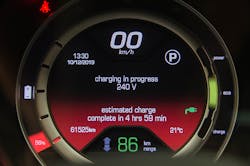Considering that this year marks the 20th anniversary of the U.S. debut of the Toyota Prius, I should have more confidence about the surfeit of alternative-fuel vehicles coming our way – mainly electric and plug-in hybrid cars and trucks. For five years or so we have reported on the various efforts of metalcasters to prepare themselves for the changing design and component requirements that EVs will inaugurate. Those preparations – including developing new lightweight alloys and casting protocols and investing in the capital equipment necessary to execute those in production scale – are interesting and salutary in their own right. And the metalcasters are not the only automotive suppliers adjusting themselves for what is coming.
So, to say I lack confidence in this process is not to indicate I doubt the capability of these suppliers, nor do I doubt that the EVs will be built. The automakers can barely hide their enthusiasm about their transformation plans.
General Motors boasts it has “an all-electric future” and has committed to have 30 new EVs available by 2025. It has $4.5-billion in upgrades and expansions going on now at multiple sites, preparing for the new vehicles’ production and assembly, and recently it said will increase spending on electric-vehicle program development by 35%, to over $27 billion. It plans to make EVs 40% of its U.S. product line.
The world’s other automakers – BMW, Ford, Honda, Mercedes, Toyota, VW, etc. – are similarly determined to make their commitments well known and admired. Who are they working to impress?
If it is the ordinary new-car buyer, they have more work to do. According to a McKinsey & Co. report, in 2019 EVs reached a peak sales volume with more than 2 million units sold worldwide, or 2.5% of the global light-vehicle (LV) market. But EV sales of cratered in 2020, down -19% from the previous year. The global pandemic surely had a part in the decline, but there is still no sign of a trend in consumer demand that will drive EV sales over that 2.5% peak — and justify automakers’ big plans.
McKinsey maintains that global “consumer demand for EVs has remained relatively stable during the (Covid-19) crisis when compared with demand for other vehicles,” but allowed that in the U.S. consumer demand for EVs has dropped, and that all demand forecasts must be reconsidered.
Consumers are fickle and American consumers can be moved by marketing efforts and fashion trends, so new products could begin to shape their tastes in the model years ahead. It is surely possible that a market will emerge to justify the new products on the way. But the car-buying public has had 20 years to shape their own tastes, and only big-ticket luxury EV models have made much a lasting impression.
In any case, my lack of confidence is not focused particularly on the consumers’ level of interest in electric vehicles, but on their readiness for the changes that will follow an unasked-for overhaul of the automotive-based economy. Are the estimated 168,000 service stations in the U.S. prepared to have their core offering sidelined? Do they have a plan for adjusting to the change? How many of their wage-earning employees will be affected? And will those workers be able to afford their own EV in those new circumstances?
The same series of questions may be asked about auto service shops and their employees.
How will insurance companies assess the overall risk in vehicle profiles and the driving populace with such a change? How will any actuarial changes affect drivers of internal-combustion engine (ICE) vehicles?
The most consequential unexamined question in this matter is the availability and provision of electricity to power the new EVs. Will drivers be able to charge their EVs at home? Are electric utilities prepared for this shift in residential requirements? Are insurance companies prepared to cover the risk of high-voltage charging stations in homes? Are drivers aware of any of these unresolved details?
The role and sentiments of consumers in our free-market economy has been minimized in recent decades, relegated to researchers’ analytics and marketers’ assurances. And consumers are generally willing to adjust themselves to new circumstances – providing they are left with some choices, some autonomy about their circumstances. As the past 12 months of shutdowns and curfews have proven, expecting individuals to accept decisions without consultation makes them something less than customers or even consumers. And they’re not buying it.
About the Author
Robert Brooks
Content Director
Robert Brooks has been a business-to-business reporter, writer, editor, and columnist for more than 20 years, specializing in the primary metal and basic manufacturing industries. His work has covered a wide range of topics, including process technology, resource development, material selection, product design, workforce development, and industrial market strategies, among others.
